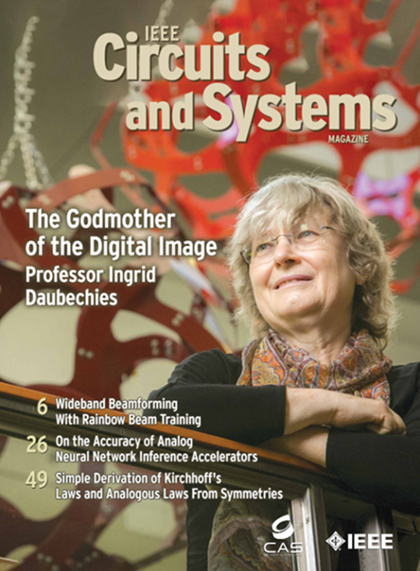A Different View of Sigma-Delta Modulators Under the Lens of Pulse Frequency Modulation [Feature]
IF 5.6
2区 工程技术
Q1 ENGINEERING, ELECTRICAL & ELECTRONIC
引用次数: 0
Abstract
The fact that VCO-ADCs produce noise-shaped quantization noise suggests that a link between frequency modulation and Sigma-Delta modulation should exist. The connection between a VCO-ADC and a first-order Sigma-Delta modulator has been already explained using Pulse Frequency Modulation. In this article, we attempt to extend this explanation to a generic Sigma-Delta modulator. We show that the link between Sigma-Delta modulation and Pulse Frequency Modulation relies in a sampling invariance property that defines the equivalence between both entities. This equivalence property, allows to go beyond the white quantization noise model of a Sigma-Delta modulator, revealing the origin of some nonlinear phenomena. We first predict spurious tones which cannot be explained by circuit non linearity. Multi-bit and single-bit modulators are shown to belong to a same generic class of systems. Finally, quantizer overload is analyzed using our model. The results are applied to Continuous-Time Sigma-Delta modulators of orders one, two and three and then extended to a generic case.从脉冲频率调制的角度看Σ-Δ调制器 [特写]
VCO-ADC 产生噪声形量化噪声这一事实表明,频率调制与 Sigma-Delta 调制之间应该存在联系。VCO-ADC 与一阶 Sigma-Delta 调制器之间的联系已通过脉冲频率调制进行了解释。在本文中,我们尝试将这一解释扩展到一般的 Sigma-Delta 调制器。我们表明,Σ-Δ调制与脉冲频率调制之间的联系依赖于采样不变性属性,该属性定义了两个实体之间的等价性。这种等价性使我们能够超越Σ-Δ调制器的白量化噪声模型,揭示一些非线性现象的起源。我们首先预测了电路非线性无法解释的杂音。多比特和单比特调制器被证明属于同一类系统。最后,使用我们的模型对量化器过载进行了分析。分析结果适用于阶次一、二和三的连续时间Σ-Δ调制器,然后扩展到一般情况。
本文章由计算机程序翻译,如有差异,请以英文原文为准。
求助全文
约1分钟内获得全文
求助全文
来源期刊

IEEE Circuits and Systems Magazine
工程技术-工程:电子与电气
CiteScore
9.30
自引率
1.40%
发文量
34
审稿时长
>12 weeks
期刊介绍:
The IEEE Circuits and Systems Magazine covers the subject areas represented by the Society's transactions, including: analog, passive, switch capacitor, and digital filters; electronic circuits, networks, graph theory, and RF communication circuits; system theory; discrete, IC, and VLSI circuit design; multidimensional circuits and systems; large-scale systems and power networks; nonlinear circuits and systems, wavelets, filter banks, and applications; neural networks; and signal processing. Content also covers the areas represented by the Society technical committees: analog signal processing, cellular neural networks and array computing, circuits and systems for communications, computer-aided network design, digital signal processing, multimedia systems and applications, neural systems and applications, nonlinear circuits and systems, power systems and power electronics and circuits, sensors and micromaching, visual signal processing and communication, and VLSI systems and applications. Lastly, the magazine covers the interests represented by the widespread conference activity of the IEEE Circuits and Systems Society. In addition to the technical articles, the magazine also covers Society administrative activities, as for instance the meetings of the Board of Governors, Society People, as for instance the stories of award winners-fellows, medalists, and so forth, and Places reached by the Society, including readable reports from the Society's conferences around the world.
 求助内容:
求助内容: 应助结果提醒方式:
应助结果提醒方式:


